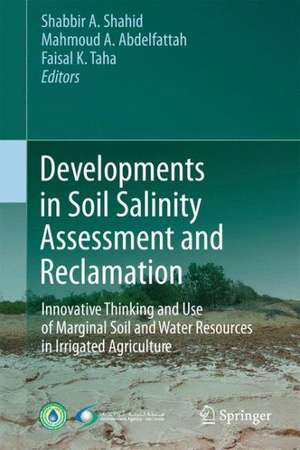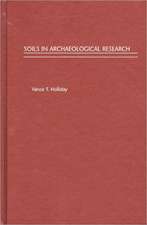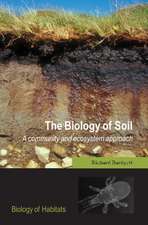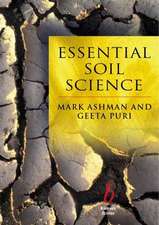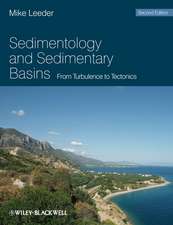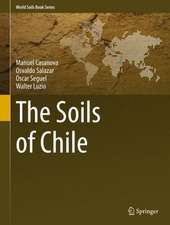Developments in Soil Salinity Assessment and Reclamation: Innovative Thinking and Use of Marginal Soil and Water Resources in Irrigated Agriculture
Editat de Shabbir A. Shahid, Mahmoud A. Abdelfattah, Faisal K. Tahaen Limba Engleză Hardback – 14 ian 2013
| Toate formatele și edițiile | Preț | Express |
|---|---|---|
| Paperback (1) | 1078.07 lei 38-44 zile | |
| SPRINGER NETHERLANDS – 23 aug 2016 | 1078.07 lei 38-44 zile | |
| Hardback (1) | 1263.82 lei 6-8 săpt. | |
| SPRINGER NETHERLANDS – 14 ian 2013 | 1263.82 lei 6-8 săpt. |
Preț: 1263.82 lei
Preț vechi: 1541.24 lei
-18% Nou
Puncte Express: 1896
Preț estimativ în valută:
241.86€ • 247.69$ • 201.19£
241.86€ • 247.69$ • 201.19£
Carte tipărită la comandă
Livrare economică 18 martie-01 aprilie
Preluare comenzi: 021 569.72.76
Specificații
ISBN-13: 9789400756830
ISBN-10: 9400756836
Pagini: 860
Ilustrații: LI, 808 p.
Dimensiuni: 155 x 235 x 51 mm
Greutate: 1.77 kg
Ediția:2013
Editura: SPRINGER NETHERLANDS
Colecția Springer
Locul publicării:Dordrecht, Netherlands
ISBN-10: 9400756836
Pagini: 860
Ilustrații: LI, 808 p.
Dimensiuni: 155 x 235 x 51 mm
Greutate: 1.77 kg
Ediția:2013
Editura: SPRINGER NETHERLANDS
Colecția Springer
Locul publicării:Dordrecht, Netherlands
Public țintă
ResearchCuprins
Part I High-tech in Soil Salinity Mapping and Monitoring.- 1. Developments in Soil Salinity Assessment, Modeling, Mapping and Monitoring from Regional to Submicroscopic Scales.- 2. Soil Salinity Modelling, Approaches and Key Issues.- 3. Quantification of the Salt Content of Soils Under Different Climatic Conditions on a National Scale in South Africa.- 4. Soil Salinizaion Assessment and Monitoring at Boe Klue District, Nan Province, Northern Thailand.- 5. Soil Salinity Mapping Using Multi-Temporal Satellite Images in Agricultural Field of Syrdary Province of Uzbekistan.- 6. The New Map of Soil Salinity and Regularities in Distribution of Salt-Affected Soils in Russia.- 7. Soil Salinity Mapping in the Sinai Peninsula of Egypt Using Geographic Information System and Remote Sensing Techniques.- 8. Spatial Variability of Soil Salinization as Judged from the Comparison of Soil Maps and Remote Sensing Materials for Different Years in Uzbekistan.- 9. Soil Salinity in the Central Arid Region of Iran - Esfahan Province.- 10. Mapping the Risk of Soil Salinization Using Electromagnetic Induction and Non-Parametric Geostatistics .- 11. Spatiotemporal Variability and Mapping of Groundwater Salinity in Tadla: Geostatistical Approach.- 12. Spatial Analysis Using a Proportional Effect Semivariogram Model.- 13. Spatial Monitoring of Soil Salinity and Prospective Conservation Study for Sinnuris District Soils, Fayoum, Egypt.- 14. Geographical Distribution of Soil Salinity, Alkalinity and Calcicity within Fayoum and Tamia Districts, Fayoum Governorate, Egypt.- 15. Using Remotely-Sensed Soil Conductivity to Monitor Restoration Activities on Vernal Pools, Northern Great Basin, USA.- 16. Mapping and Monitoring of Salt-Affected Soils Using Remote Sensing and Geographic Information System for the Reclamation of Canal Commanded Area of Jammu, India.- Part II Management and Reclamation of Salt-Affected Soils .- 17. Management of Saline Lands inOman: Learning to Live with Salinity.- 18. Rice Production in Salt-Affected Soils of Pakistan Using Different Reclamation Techniques .- 19. Marginal-Quality Water Use as an Ameliorant for Tile-Drained Saline-Sodic Soils in a Rice-Wheat Production System.- 20. Reclamation of Degraded Vertisols Under Cassava in Arid Environments of India.- 21. Sustainable Management of Salt Affected Soils and Poor Quality Ground Waters for Enhancing Crop Production.- 22. Controlling Sodic Soil Erosion by Electrolytes and Polyacrylamide Application.- 23. Practical, Productive and Environment Friendly Utilization of Different Categories of Salt-Affected Soils in Arid and Semi-Arid Regions of Pakistan.- 24. The Reclamation Effects Should be Considered for Saline Soil Criteria in Soil Classification System.- Part III Use of Marginal Quality Water for Crop Production .- 25. Use of Marginal Quality Waters for Sustainable Crop Production.- 26. Distichlis Spicata – A Salt and Drought Tolerant Plant Species with Minimum Water Requirements for Sustainable Agriculture in Desert Regions and Biological Reclamation of Desert Saline Soils.- 27. Relative Salinity Tolerance of 35 Lolium spp. Cultivars for Urban Landscape and Forage Use.- 28. Enhances the Quality of Turfgrasses with Saline Groundwater.- 29. Plant Response to Saline Water Irrigation in a Sicilian Vineyard.- 30. Yield and Growth Responses of Autochthonous Pearl Millet Ecotype (Pennisetum glaucum (L.) R. Br.) Under Saline Water Irrigation in Tunisia.- 31. Use of Marginal Water for Salicornia bigelovii Torr. Planting in the United Arab Emirates.- 32. Performance of Chenopodium quinoa Under Salt Stress.- 33. Inducing Pea Plants for Conquering the Adverse Conditions of Saline Reclaimed Soils with Some Support Application.- 34. Prospects of Crop and Forage Production in Coastal Saline Soils of Bangladesh.- IV. Salt-Tolerance Mechanisms in Plants.- 35. Salt Response of Some Halophytes with Potential Interest in Reclamation of Saline Soils -Gas Exchange, Water Use Efficiency and Defense Mechanism.- 36. Salt Response of Halophytes with Potential Interest in Food Crops and Reclamation of Saline Soils, Growth, Water Relations, Mineral Content and Anatomical Adaptations.- 37. Biology and Physiology of Avicennia Marina in the Coastal Conditions of Southern Morocco.- V. Biosaline Agriculture and Agroforestry for Marginal Lands.- 38. Integrating Agroforestry and Pastures for Soil Salinity Management in Dryland Ecosystems in Aral Sea Basin.- 39. Atriplex Production under Saline Soil and Saline Irrigation Practices.- 40. Exploring Saline Lands Improvement through Testing Leptochloa Fusca and Sporobolus Virginicus in Egypt.- 41. Improvement of Soil Quality through Agro-Forestry System for Central Plain Zone of Uttar Pradesh India.- VI. Microbiological Interventions for Marginal Soils and Water Resources.- 42. Bacterial Exo-Polysaccharides: A Biological Tool for the Reclamation of Salt-Affected Soils.- VII. Opportunities and Challenges in Using Marginal Waters.- 43. Agriculture Use of Marginal Water in Egypt: Opportunities and Challenges.- 44. Marginal Water in Agriculture and Food Crisis in Sub Sahara Africa.- VIII. Water Quality, Soil and Water Management in Irrigated Agriculture.- 45. Water Quality of Medjerda Wadi used for Irrigation Purpose (Eastern Algeria) .- 46. Exploring Soil Salinity Management in Entisols using Trickle Irrigation System.- 47. Suitability of Surface Water from Mouillah Wadi Of Algeria for Irrigation Purposes.- 48. Water Use Efficiency for Leaching Saline Sodic Clayey Soils, Case Study- Tina Plain Area of Egypt.- 49.The Performamce of Sunflower, Turnip and Forage Corn in Uptaking Some Essential Elements and Cadmium under Wastewater Irrigation.- 50. Sustainable Agriculture through Integrated Soil Fertility Management on Degraded Lands.- 51. Use of Conservation Tillage System in Semiarid Region to Ensure Wheat Food Security in Pakistan.- 52. Effect ofSalinity and Bentonite on the Characteristics of Mineral Soil and Behavior of Leguminous Plants (Vicia Faba L.).- Author Index.- Subject Index.
Textul de pe ultima copertă
This important addition to the technical literature of ecology is a storehouse of information on marginal soils and waters from around the world. Soil salinity is considered the most important component of land degradation in arid and semi-arid regions, it is dynamic, spreading globally in over 100 countries and covering more than one billion hectares. It is causing significant losses in irrigated agriculture due to poor understanding and management. There have been significant developments in technologies to assess, map and monitor soil salinization spatially and temporally using remote sensing, geographical information system, geophysical methods and modeling, from regional, national to farm levels.
The papers assembled here cover topics such as technological advances in soil salinity mapping and monitoring, management and reclamation of salt-affected soils, use of marginal quality water for crop production, salt-tolerance mechanisms in plants, biosaline agriculture and agroforestry, microbiological interventions for marginal soils, opportunities and challenges in using marginal waters, and soil and water management in irrigated agriculture.
Focusing on arid and semi-arid regions, the book details recent developments in soil salinity and reclamation aspects in an applied context. Once this information is properly assimilated and applied in the field by potential stakeholders the agriculture scientists and farmers, marginal soil productivity may be increased leading to improved livelihood for farmers.
The papers assembled here cover topics such as technological advances in soil salinity mapping and monitoring, management and reclamation of salt-affected soils, use of marginal quality water for crop production, salt-tolerance mechanisms in plants, biosaline agriculture and agroforestry, microbiological interventions for marginal soils, opportunities and challenges in using marginal waters, and soil and water management in irrigated agriculture.
Focusing on arid and semi-arid regions, the book details recent developments in soil salinity and reclamation aspects in an applied context. Once this information is properly assimilated and applied in the field by potential stakeholders the agriculture scientists and farmers, marginal soil productivity may be increased leading to improved livelihood for farmers.
Caracteristici
Covers advances in soil salinity mapping and monitoring, management and reclamation of salt-affected soils Offers agricultural improvements for use of marginal quality water in crop production, salt-tolerance mechanisms in plants and more Expertly developed and organized to present the latest advances and science on soil salinity in arid and semi-arid regions Includes supplementary material: sn.pub/extras
